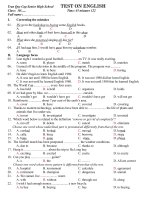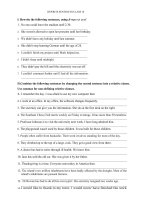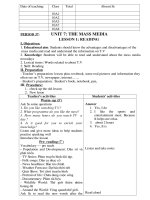J Frecknall-Hughes TARC Master Class 10 October 2014
Bạn đang xem bản rút gọn của tài liệu. Xem và tải ngay bản đầy đủ của tài liệu tại đây (881.72 KB, 55 trang )
Tax Administration Research
Centre
Master Class, London
10 October 2014
THE WORK OF TAX
PRACTITIONERS
Professor Jane Frecknall-Hughes
Hull University Business School
Overview…
Part 1: analysis
The work of tax practitioners
Part 2: a theory of
working
Part 3: judging quality
3
Part 1, Analysis: Overview
Topicality.
Definition of a tax practitioner.
The nature of the taxation services market.
Review of the taxation practitioner literature.
A conceptual analysis of the work of tax
practitioners.
3
Pt 1: Topicality
4
Pt 1: Definition of a tax practitioner
“…covers a diverse group of individuals, business structures
and professional groups who provide a range of tax services
for their clients. Self-employed and in-house accountants, tax
advisers and registered tax agents, tax agent franchises and
legal practitioners in the tax area are all embraced by the term
‘tax practitioner’ ”.
Devos, 2012: 5
Terms used – tax practitioner, tax preparer, tax professional,
tax adviser, tax agent, tax intermediary, tax ‘structurer’, etc.
Roles played – tax return preparer, responder to return
queries, adviser on ‘tax minimisation’, valuer/mediator,
‘servant’ of tax authority in investigation.
5
Pt 1: Definition of a tax practitioner (cont.)
Responsible to:
Their client (primarily) (regular or one-off)
The government (as intermediary)
Their firm
Their profession
The wider public
Themselves
–
but rather depends on what the practitioner actually does!
A tax practitioner is often referred to as ‘tax agent’ but not
strictly an ‘agent’ in the true meaning of the word.
6
Pt 1: Nature of the taxation services market
The market is characterised by fragmentation, though the
degree varies.
In the UK, tax services are provided by members of:
- professional tax/accountancy bodies (CIOT, ATT, IIT
(merged with CIOT), ACCA, ICAEW, ICAS, STEP, WCOTA);
- the legal profession (solicitors, barristers)
- former members of tax authorities in private practice
- the tax authority
…working in a variety of entities:
- accounting firms (Big Four, medium, small)
- legal firms
- specialist tax firms
- tax/financial functions of, for example, MNEs
- tax authority or other public sector entities
7
Pt 1: Nature of the taxation services market
(cont.)
→ Lack of professional monopoly and fragmented
professional regulation.
Anyone in the UK can set up in business as a tax practitioner.
HMRC (2009) suggests that there are some 12,000 tax
practitioners currently unregulated by any professional body.
The situation varies elsewhere. Australia and the USA
require registration of certain types of practitioner, but not
others, with the USA showing variation across different
states.
→ Has resulted in lack of holistic study of the work of tax
practitioners, so there is little conceptual/theoretical analysis
8
of practitioners’ work.
Pt 1: Review of the tax practitioner literature
Surveys (USA and Australia) suggest a significant
proportion of taxpayers use practitioner services (USA now >
50%).
An extensive literature (mostly US-based) suggests the
following reasons:
- Correct preparation of return*
- Paying the least tax required (not equating to aggressive
tax avoidance) but some willing to overpay to save time)
- Avoidance of serious tax penalties
- Reducing likelihood of investigation/audit
- Increasing complexity of the tax system
- Legal ambiguity over type of income received*
* Linked to risk. More uncertainty → less risk taking by
taxpayers, but more by practitioners.
9
Pt 1: Review of the literature (cont.)
There is a significant amount of literature which focuses on
factors affecting taxpayers’ compliance – general import
being that perceptions of probable detection and severity of
penalties deter non-compliance.
Until recently this body of literature did not consider the likely
impact of using a tax practitioner.
The existing studies report that tax practitioners both
increase and decrease levels of compliance, explained by
Klepper and Nagin (1989) and Klepper et al. (1991):
practitioners are “enforcers” in unambiguous contexts and
“exploiters” in ambiguous ones…
10
Pt 1: Review of the literature (cont.)
…practitioners’ levels of aggressiveness are affected by:
- Client attributes (quality of records, etc.)
- Their own concern about penalties
- Possible loss of an important client …with one of more of
- Opinions of others in the firm
these working in
- Advocacy posture
combination
- Client risk preferences
- Levels of ambiguity in a particular issue
- Whether tax is due by the client
- Experience with tax authority
- Probability of tax investigation
- Type of firm
- CPA status or not
- Single of group decision taking
- Education level
11
- Ethical concerns
Pt 1: A conceptual analysis of the work of tax
practitioners
The literature refers to specific
types of work done by practitioners
(another variable?), but there is
little conceptual analysis.
What is going on?
12
Pt 1: A conceptual analysis of the work of tax
practitioners (cont.)
Thuronyi and Vanistendael (1966: 148–151) suggested:
Tax planning
Advice ancilliary to financial and other services
Preparation and auditing of commercial accounts
Preparation of tax returns
Representation of the taxpayer before the tax
administration
Representation before the courts
13
Pt 1: A conceptual analysis of the work of
tax practitioners (cont.)
1.
Tax compliance work
Preparation of returns on
behalf of the taxpayer for
submission to HMRC.
Involves reporting economic events that have occurred…
…but using such latitude as allowed to present
information to client’s best interest (repairs v capital) – law
clear, but situation to which it is applied may not be and
may be genuine uncertainty.
14
Pt 1: A conceptual analysis of the work of tax
practitioners (cont.)
2. Tax planning/avoidance work
Definite and deliberate
manipulation of taxpayer’s affairs to reduce tax payable:
Acceptable, e.g., IHT reliefs, use of ISAs.
Stretching statute where law is unclear, but filtered
by DOTAS.
Tax arbitrage.
Comments from the cases of Ayrshire Pullman and the
Duke of Westminster, etc., used to support the legitimacy of
avoidance, and Ramsay, etc., its unacceptability, but NB
Hurlingham Estates Ltd v Wilde & Partners, Mehjoo v Harben
15
Barker and HMRC GAAR guidance .
Pt 1: A conceptual analysis of the work of tax
practitioners (cont.)
Legislative enactments of various kinds, e.g., TAARs.
Resorting to the Courts, e.g., Ramsay and many other
cases (‘substance over form’ arguments and its
developments).
From 2004, DOTAS.
The ‘moral card’, presaged by Lord Denning in Re
Weston’s Settlements, and the change in language, tied
more recently into emotional response against ‘tax
arbitrage’.
The current GAAR.
16
Pt 1: A conceptual analysis of the work of
tax practitioners (cont.)
Terminology shifts:
aggressive
unacceptable
abusive
illegitimate
illegal
Avoidance as ‘morally repugnant’ (presaged in Re
Weston’s Settlements).
Body of work on tax practitioners and ethics (e.g., Doyle et
al., 2012, 2013).
17
Part 2, A Theory of Working: Overview
The lacuna
Possible theories of tax practice
Negotiation theory
18
Pt 2: The lacuna
“There is at present no general theory of tax practice. Rather
there exists a small collection of studies that focus on
particular features of this institution.”
Erard, 1993: 164
19
Pt 2: The lacuna (cont.)
This situation persists, with continued studies – and
continued great interest, because of help needed
from practitioners to comply with complex law and
because of alleged involvement in avoidance (e.g.,
Starbucks et al., the PAC).
So – practitioners help their clients to comply and
(apparently) not to comply: how then to reconcile
these apparently conflicting roles?
20
Pt 2: Possible theories of tax practice
Several theories might be considered to fit the complex work
of tax practitioners:
Game theory
Agency theory
Exchange theory
Prospect theory
Stakeholder theory (not included in the paper, but also
possible)
…but negotiation theory fits best.
21
Pt 2: Negotiation theory
“Negotiation deals with two participants who have different
needs and viewpoints attempting to reach an agreement on
matters of mutual interest.”
Martin et al., 1999: 65
“Negotiation is a decentralized decision-making process that
seeks to find an agreement that will satisfy the requirements
of two or more parties in the presence of limited common
knowledge and conflicting preferences. Negotiation
participants are agents who negotiate on their own behalf or
represent the interests of their principals.”
Braun et al., 2006: 271
22
Pt 2: Negotiation theory (cont.)
The role of negotiation is greatly under-appreciated and is
relevant in contexts wider than conflict resolution. There is
now an extensive literature, often with a practical focus (e.g.,
ADR), but little theory.
Wall Jr. (1985: 4) defines negotiation as:
“a process through which two or more parties coordinate an
exchange of goods or services and attempt to agree upon the
rate of exchange for them. In this interaction, the primary
objective may be an agreement or any other outcome
indigenous to or resulting from the ongoing exchange.”
Here comes the first intimation that in a tax scenario more
may be involved than simply agreeing with a tax inspector
how much tax a taxpayer should pay.
23
Pt 2: Negotiation theory (cont.)
24
Pt 2: Negotiation theory (cont.)
Stages of negotiation
Establishing the negotiation range
Reconnoitring the negotiation range
Precipitating the negotiation range
25









